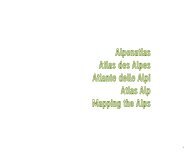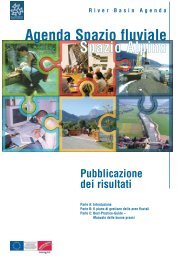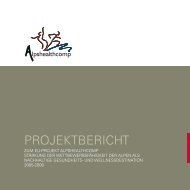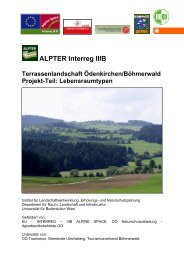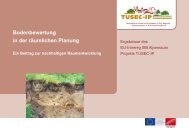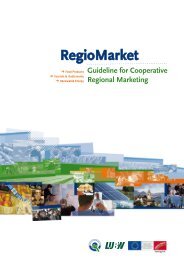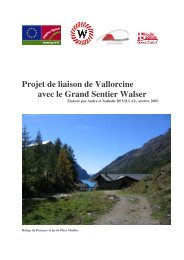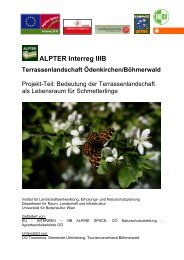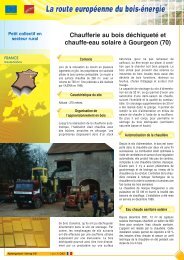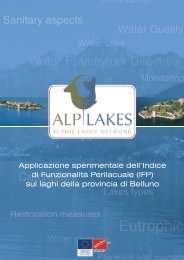WALSERSPRACHE - The four main objectives of the Alpine Space ...
WALSERSPRACHE - The four main objectives of the Alpine Space ...
WALSERSPRACHE - The four main objectives of the Alpine Space ...
Create successful ePaper yourself
Turn your PDF publications into a flip-book with our unique Google optimized e-Paper software.
DAS „WALSERDEUTSCHE“ IM OBERWALLIS<br />
would like to briefly outline <strong>the</strong> <strong>main</strong> phonetic and grammatical differences <strong>of</strong> Swiss<br />
German, fully aware that <strong>the</strong> only permanent milestone holding firm for all Walsers is <strong>the</strong><br />
shift from Germanic “s” to “sch”. All Walsers are aware <strong>of</strong> <strong>the</strong> fact that it is by virtue <strong>of</strong><br />
“iisch, insch, üüsch, ünsch” that <strong>the</strong>y will set <strong>the</strong>mselves apart from <strong>the</strong>ir not-Walser<br />
neighbours. <strong>The</strong> re<strong>main</strong>ing <strong>main</strong> differences surface in each <strong>of</strong> <strong>the</strong> Walser areas in different<br />
and unconfined ways. Let us now come to common traits <strong>of</strong> Walser dialects. Beside<br />
phonetic and grammatical common traits we have additional and interesting links. <strong>The</strong>re<br />
are names designating things, objects, common situations which are universally widespread<br />
and common throughout <strong>the</strong> Walser world. Needless to say <strong>the</strong>ir pronunciation may<br />
somewhat differ from place to place, but on <strong>the</strong> whole <strong>the</strong>se differences stem from <strong>the</strong> start<br />
language itself. What is <strong>the</strong>n <strong>the</strong> problem with Walliserdeutsch? Well, <strong>the</strong> problem with<br />
Walliserdeutsch is that <strong>the</strong>re is no Walliserdeutsch! <strong>The</strong> Higher Wallis region was settled<br />
from <strong>the</strong> East and from <strong>the</strong> West in <strong>the</strong> 7 th century, which led to a pronunciation rift on <strong>the</strong><br />
territory settled by <strong>the</strong> Walsers, a sort <strong>of</strong> “ee”-“ää” — “du”-“düü” borderline. This split can<br />
be still traced nowadays, it is a commonly known phenomenon, while o<strong>the</strong>r discrepancies<br />
may be less well recognised, like <strong>the</strong> difference between “känne” (“kennen” in Alagna) and<br />
“bkenne” (“kennen” in Pomatt). So it is mandatory to go back to Walliserdeutsch when one<br />
deals with Walser dialects. A mighty good tool to that end is <strong>the</strong> Language Atlas <strong>of</strong> Germanspeaking<br />
Switzerland, which includes <strong>the</strong> Walser areas in Nor<strong>the</strong>rn Italy as well. Besides<br />
clear-cut boundaries, <strong>the</strong>re are many o<strong>the</strong>r local peculiarities which mark out <strong>the</strong> origin <strong>of</strong><br />
speakers in Higher Wallis and <strong>the</strong> Walsers took <strong>the</strong>se peculiarities with <strong>the</strong>m as <strong>the</strong>y settled<br />
elsewhere. <strong>The</strong> fact that <strong>the</strong>re is no Wallis dictionary can be presumably ascribed to <strong>the</strong> fact<br />
that <strong>the</strong>re is no unified Walliserdeutsch language. <strong>The</strong>re is a rich literature in this language<br />
or in <strong>the</strong> dialects from various territories. <strong>The</strong>re are isolated attempts to create dictionaries<br />
and <strong>the</strong>re is a word choice by Vogel which was published as a comparative dictionary<br />
by Dr. Alois Grichting. In addition to that, under <strong>the</strong> topic “buildings” I have attempted to<br />
illustrate <strong>the</strong> word gamut available in this field by means <strong>of</strong> a small dictionary. <strong>The</strong> bibliography<br />
in this work <strong>of</strong>fers cross-references to a lot <strong>of</strong> publications on <strong>the</strong> <strong>the</strong>me <strong>of</strong><br />
Walliserdeutsch. In <strong>the</strong> following list I would like to point out a small choice or particularly<br />
meaningful works (see first list in <strong>the</strong> report). Ever since its inception <strong>the</strong> International<br />
Union for Walser Affairs and Language has been taking care <strong>of</strong> Walser culture and, above<br />
all, Walser language. It has steadily tried to foster language and culture above all in<br />
Nor<strong>the</strong>rn Italy. To pursue this goal its deploys <strong>the</strong> following tools (see second list in report).<br />
163



